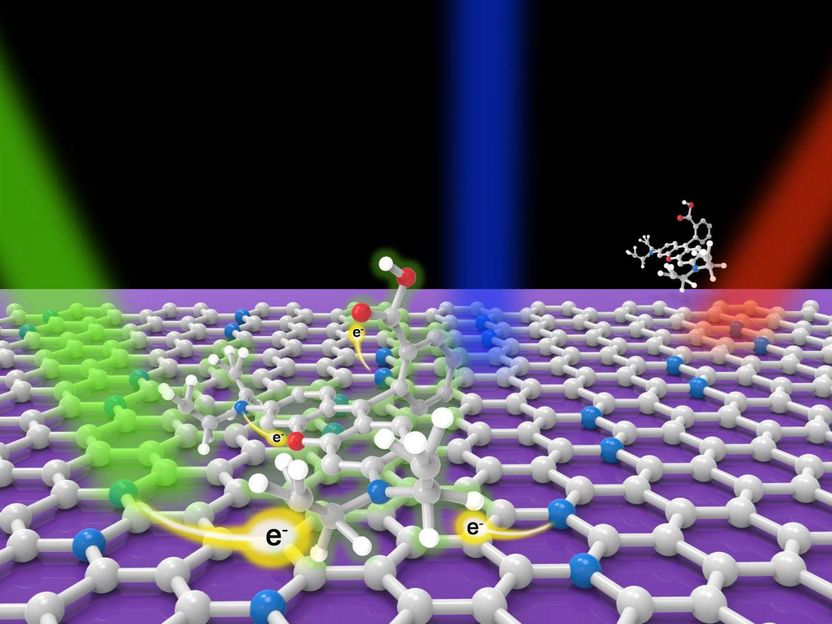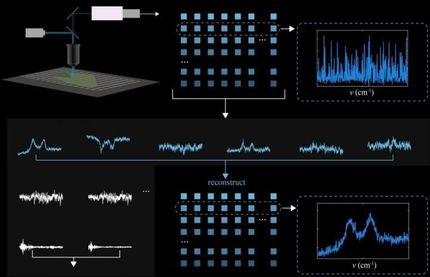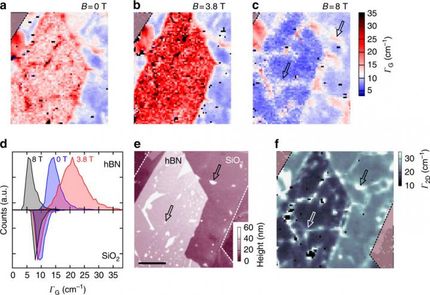Ultrasensitive sensor using N-doped graphene
A highly sensitive chemical sensor based on Raman spectroscopy and using nitrogen-doped graphene as a substrate was developed by an international team of researchers working at Penn State. In this case, doping refers to introducing nitrogen atoms into the carbon structure of graphene. This technique can detect trace amounts of molecules in a solution at very low concentrations, some 10,000 times more diluted than can be seen by the naked eye.

A model is showing the charge transfer (e-) mechanism of Rhodamine B molecules (top) interacting with N-doped graphene (bottom sheet) when excited with different laser lines, which leads to ultrasensitive molecular sensor with N doped graphene. The white, blue and red balls represent carbon, nitrogen and oxygen atom respectively.
Terrones Lab, Penn State
Raman spectroscopy is a widely adopted identification technique used in chemistry, materials science and the pharmaceutical industry to detect the unique internal vibrations of various molecules. When a laser light irradiates crystals or molecules, it scatters and shifts colors. That scattered light can be detected in the form of a Raman spectrum, which serves almost as a fingerprint for every Raman-active irradiated system.
"Basically, different colors in the visible spectrum will be associated to different energies," said Mauricio Terrones, professor of physics, chemistry and materials science at Penn State, who led the research. "Imagine each molecule has a particular light color emission, sometimes yellow, sometimes green. That color is associated with a discrete energy."
The team chose three types of fluorescent dye molecules for their experiments. Fluorescent dyes, which are frequently used as markers in biological experiments, are particularly hard to detect in Raman spectroscopy because the fluorescence tends to wash out the signal. However, when the dye is added to the graphene or N-doped graphene substrate, the photoluminescence -- fluorescence -- is quenched.
On its own, the Raman signal is so weak that many methods have been used to enhance the signal. A recently developed enhancement technique uses pristine graphene as a substrate, which can enhance the Raman signal by several orders of magnitude. In a paper published online today (July 22) in the journal Science Advances, Terrones and colleagues revealed that adding nitrogen atoms to the pristine graphene further enhances sensitivity and, importantly, they gave a theoretical explanation for how graphene and N-doped graphene cause the enhancement.
"By controlling nitrogen doping we can shift the energy gap of the graphene, and the shift creates a resonance effect that significantly enhances the molecule's vibrational Raman modes," said lead author Simin Feng, a graduate student in Terrones' group.
"This is foundational research," said Ana Laura Elias, a coauthor and research associate in Terrones' lab. "It is hard to quantify the enhancement because it will be different for every material and color of light. But in some cases, we are going from zero to something we can detect for the first time. You can see a lot of features and study a lot of physics then. To me the most important aspect of this work is our understanding of the phenomenon. That will lead to improvements in the technique."
Terrones added, "We carried out extensive theoretical and experimental work. We came up with an explanation of why nitrogen-doped graphene works much better than regular graphene. I think it's a breakthrough, because in our paper we explain the mechanism of detecting certain molecules."
Because of graphene's chemical inertness and biocompatibility, the team expects that the new technique will be effective in detecting trace amounts of organic molecules. Elias is excited about the prospect of combining the technique with available portable Raman spectrometers that can be taken to remote places to detect, for instance, dangerous viruses. The fluorescent dyes they studied will make it fast and easy to see the presence of compounds inside biological cells. Because the technique is simple -- just dip the graphene substrate into a solution for a short amount of time -- it should be feasible to create an entire library of the Raman spectrum of specific molecules, Terrones said.
Original publication
Feng, Simin and dos Santos, Maria Cristina and Carvalho, Bruno R. and Lv, Ruitao and Li, Qing and Fujisawa, Kazunori and Elías, Ana Laura and Lei, Yu and Perea-López, Nestor and Endo, Morinobu and Pan, Minghu and Pimenta, Marcos A. and Terrones, Mauricio; "Ultrasensitive molecular sensor using N-doped graphene through enhanced Raman scattering"; Science Advances; 2016
Most read news
Original publication
Feng, Simin and dos Santos, Maria Cristina and Carvalho, Bruno R. and Lv, Ruitao and Li, Qing and Fujisawa, Kazunori and Elías, Ana Laura and Lei, Yu and Perea-López, Nestor and Endo, Morinobu and Pan, Minghu and Pimenta, Marcos A. and Terrones, Mauricio; "Ultrasensitive molecular sensor using N-doped graphene through enhanced Raman scattering"; Science Advances; 2016
Topics
Organizations
Other news from the department science
These products might interest you

SprayMaster inspex by LaVision
Quality Control for Your Spraying Process Through Digital Spray and Particle Analysis
Reliable, Automated, Digital - The Geometry Measurement of Your Spraying Process in Real Time

FireSting-PRO by PyroScience
New fiber optic measuring device: Precise measurements even in the smallest volumes
Measure pH, oxygen and temperature even under sterile conditions

VEGAPULS | VEGABAR | VEGASWING by VEGA Grieshaber
Cyber-safe level measurement - here's how it works
Find out more about the unique sensor for liquid and solid media

Get the chemical industry in your inbox
By submitting this form you agree that LUMITOS AG will send you the newsletter(s) selected above by email. Your data will not be passed on to third parties. Your data will be stored and processed in accordance with our data protection regulations. LUMITOS may contact you by email for the purpose of advertising or market and opinion surveys. You can revoke your consent at any time without giving reasons to LUMITOS AG, Ernst-Augustin-Str. 2, 12489 Berlin, Germany or by e-mail at revoke@lumitos.com with effect for the future. In addition, each email contains a link to unsubscribe from the corresponding newsletter.
Most read news
More news from our other portals
See the theme worlds for related content
Topic World Spectroscopy
Investigation with spectroscopy gives us unique insights into the composition and structure of materials. From UV-Vis spectroscopy to infrared and Raman spectroscopy to fluorescence and atomic absorption spectroscopy, spectroscopy offers us a wide range of analytical techniques to precisely characterize substances. Immerse yourself in the fascinating world of spectroscopy!

Topic World Spectroscopy
Investigation with spectroscopy gives us unique insights into the composition and structure of materials. From UV-Vis spectroscopy to infrared and Raman spectroscopy to fluorescence and atomic absorption spectroscopy, spectroscopy offers us a wide range of analytical techniques to precisely characterize substances. Immerse yourself in the fascinating world of spectroscopy!
Topic world Sensor technology
Sensor technology has revolutionized the chemical industry by providing accurate, timely and reliable data across a wide range of processes. From monitoring critical parameters in production lines to early detection of potential malfunctions or hazards, sensors are the silent sentinels that ensure quality, efficiency and safety.

Topic world Sensor technology
Sensor technology has revolutionized the chemical industry by providing accurate, timely and reliable data across a wide range of processes. From monitoring critical parameters in production lines to early detection of potential malfunctions or hazards, sensors are the silent sentinels that ensure quality, efficiency and safety.
Last viewed contents
Enriched_uranium
Micellar_solutions
Reynold_C._Fuson
PHOLED





























































